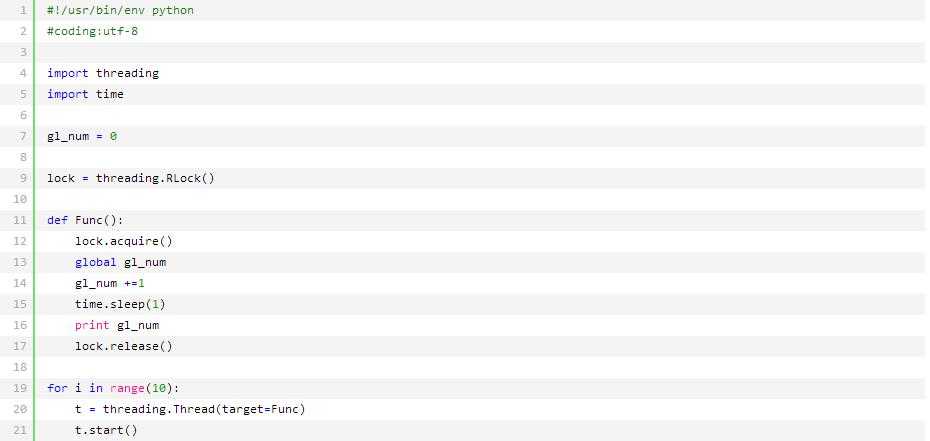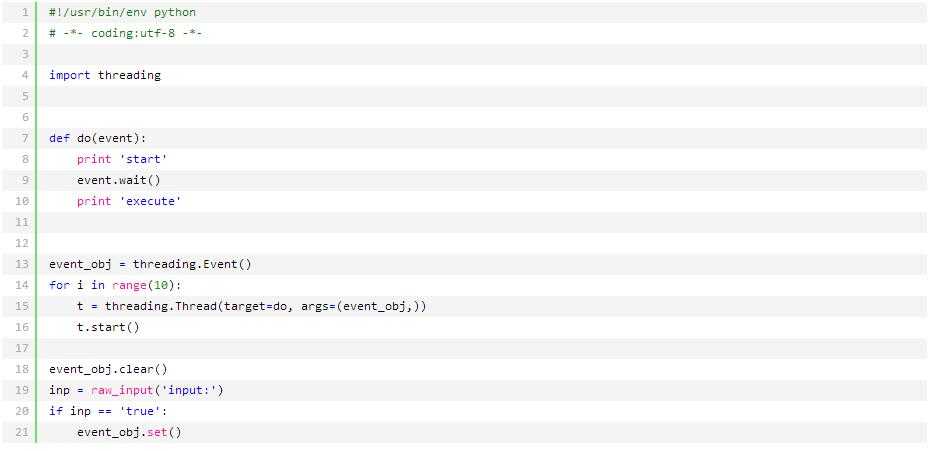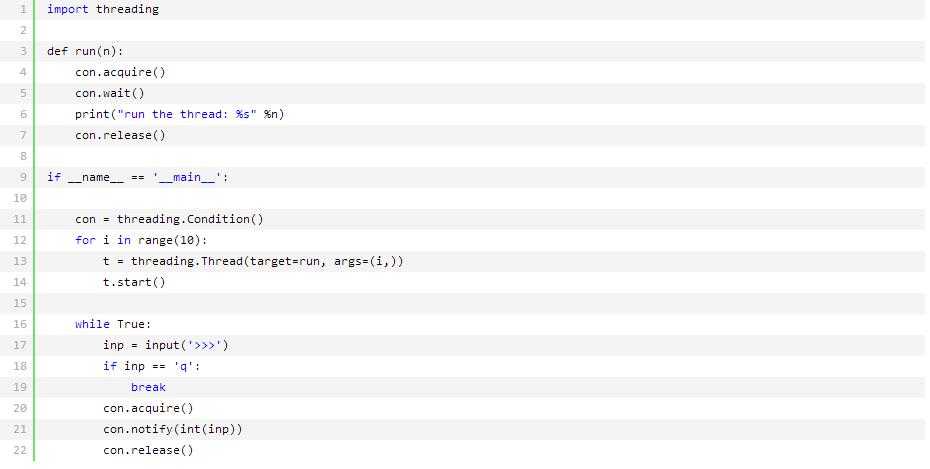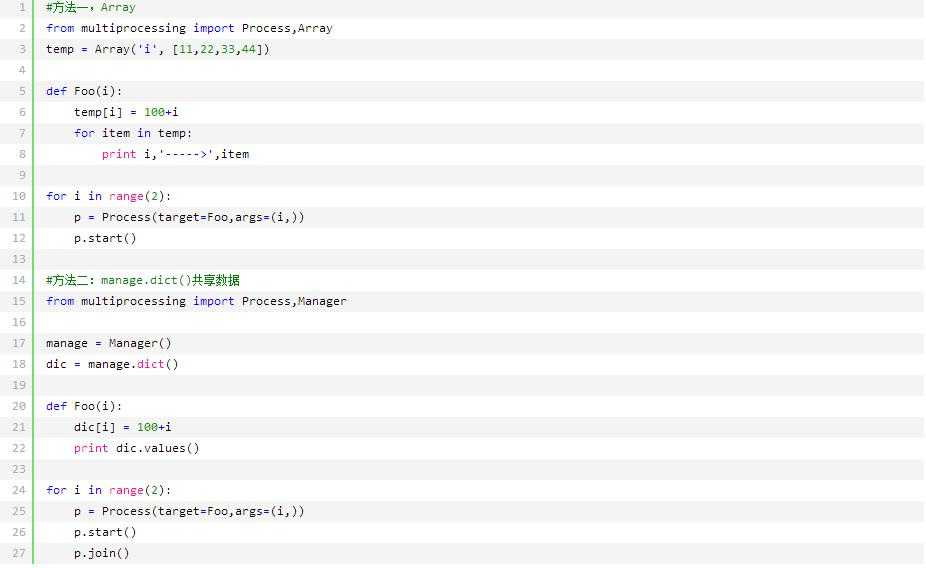标签:
一.python线程
Threading用于提供线程相关的操作,线程是应用程序中工作的最小单元。
|
1
2
3
4
5
6
7
8
9
10
11
12
13
14
|
#!/usr/bin/env python# -*- coding:utf-8 -*-import threadingimport time def show(arg): time.sleep(1) print ‘thread‘+str(arg) for i in range(10): t = threading.Thread(target=show, args=(i,)) t.start() print ‘main thread stop‘ |
上述代码创建了10个“前台”线程,然后控制器就交给了CPU,CPU根据指定算法进行调度,分片执行指令。
更多方法:

import threading import time class MyThread(threading.Thread): def __init__(self,num): threading.Thread.__init__(self) self.num = num def run(self):#定义每个线程要运行的函数 print("running on number:%s" %self.num) time.sleep(3) if __name__ == ‘__main__‘: t1 = MyThread(1) t2 = MyThread(2) t1.start() t2.start() 自定义线程类
二.线程锁(Lock、RLock)
由于线程之间是进行随机调度,并且每个线程可能只执行n条执行之后,当多个线程同时修改同一条数据时可能会出现脏数据,所以,出现了线程锁 - 同一时刻允许一个线程执行操作。

#!/usr/bin/env python # -*- coding:utf-8 -*- import threading import time gl_num = 0 def show(arg): global gl_num time.sleep(1) gl_num +=1 print gl_num for i in range(10): t = threading.Thread(target=show, args=(i,)) t.start() print ‘main thread stop‘ 未使用锁

互斥锁 同时只允许一个线程更改数据,而Semaphore是同时允许一定数量的线程更改数据 ,比如厕所有3个坑,那最多只允许3个人上厕所,后面的人只能等里面有人出来了才能再进去。
三.信号量(Semaphore)
|
1
2
3
4
5
6
7
8
9
10
11
12
13
14
15
|
import threading,timedef run(n): semaphore.acquire() time.sleep(1) print("run the thread: %s" %n) semaphore.release()if __name__ == ‘__main__‘: num= 0 semaphore = threading.BoundedSemaphore(5) #最多允许5个线程同时运行 for i in range(20): t = threading.Thread(target=run,args=(i,)) t.start() |
四.事件(event)
python线程的事件用于主线程控制其他线程的执行,事件主要提供了三个方法 set、wait、clear。
事件处理的机制:全局定义了一个“Flag”,如果“Flag”值为 False,那么当程序执行 event.wait 方法时就会阻塞,如果“Flag”值为True,那么event.wait 方法时便不再阻塞。

五.条件(Condition)
使得线程等待,只有满足某条件时,才释放n个线程


def condition_func(): ret = False inp = input(‘>>>‘) if inp == ‘1‘: ret = True return ret def run(n): con.acquire() con.wait_for(condition_func) print("run the thread: %s" %n) con.release() if __name__ == ‘__main__‘: con = threading.Condition() for i in range(10): t = threading.Thread(target=run, args=(i,)) t.start()
六.Timer

七.python进程

八.进程数据共享
进程各自持有一份数据,默认无法共享数据

#!/usr/bin/env python #coding:utf-8 from multiprocessing import Process from multiprocessing import Manager import time li = [] def foo(i): li.append(i) print ‘say hi‘,li for i in range(10): p = Process(target=foo,args=(i,)) p.start() print ‘ending‘,li 进程间默认无法数据共享


‘c‘: ctypes.c_char, ‘u‘: ctypes.c_wchar, ‘b‘: ctypes.c_byte, ‘B‘: ctypes.c_ubyte, ‘h‘: ctypes.c_short, ‘H‘: ctypes.c_ushort, ‘i‘: ctypes.c_int, ‘I‘: ctypes.c_uint, ‘l‘: ctypes.c_long, ‘L‘: ctypes.c_ulong, ‘f‘: ctypes.c_float, ‘d‘: ctypes.c_double 类型对应表

from multiprocessing import Process, Queue def f(i,q): print(i,q.get()) if __name__ == ‘__main__‘: q = Queue() q.put("h1") q.put("h2") q.put("h3") for i in range(10): p = Process(target=f, args=(i,q,)) p.start() Code
当创建进程时(非使用时),共享数据会被拿到子进程中,当进程中执行完毕后,再赋值给原值。
九.进程池
进程池内部维护一个进程序列,当使用时,则去进程池中获取一个进程,如果进程池序列中没有可供使用的进进程,那么程序就会等待,直到进程池中有可用进程为止。
进程池中有两个方法:
|
1
2
3
4
5
6
7
8
9
10
11
12
13
14
15
16
17
18
19
20
21
22
|
#!/usr/bin/env python# -*- coding:utf-8 -*-from multiprocessing import Process,Poolimport time def Foo(i): time.sleep(2) return i+100 def Bar(arg): print arg pool = Pool(5)#print pool.apply(Foo,(1,))#print pool.apply_async(func =Foo, args=(1,)).get() for i in range(10): pool.apply_async(func=Foo, args=(i,),callback=Bar) print ‘end‘pool.close()pool.join()#进程池中进程执行完毕后再关闭,如果注释,那么程序直接关闭。 |
标签:
原文地址:http://www.cnblogs.com/lijinrui/p/5737417.html